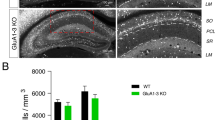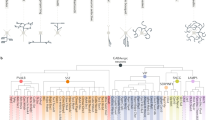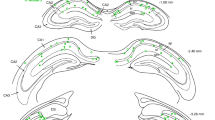Abstract
Forebrain circuits rely upon a relatively small but remarkably diverse population of GABAergic interneurons to bind and entrain large principal cell assemblies for network synchronization and rhythmogenesis. Despite the high degree of heterogeneity across cortical interneurons, members of a given subtype typically exhibit homogeneous developmental origins, neuromodulatory response profiles, morphological characteristics, neurochemical signatures and electrical features. Here we report a surprising divergence among hippocampal oriens-lacunosum moleculare (O-LM) projecting interneurons that have hitherto been considered a homogeneous cell population. Combined immunocytochemical, anatomical and electrophysiological interrogation of Htr3a-GFP and Nkx2-1-cre:RCE mice revealed that O-LM cells parse into a caudal ganglionic eminence–derived subpopulation expressing 5-HT3A receptors (5-HT3ARs) and a medial ganglionic eminence–derived subpopulation lacking 5-HT3ARs. These two cohorts differentially participate in network oscillations, with 5-HT3AR-containing O-LM cell recruitment dictated by serotonergic tone. Thus, members of a seemingly uniform interneuron population can exhibit unique circuit functions and neuromodulatory properties dictated by disparate developmental origins.
This is a preview of subscription content, access via your institution
Access options
Subscribe to this journal
Receive 12 print issues and online access
$209.00 per year
only $17.42 per issue
Buy this article
- Purchase on Springer Link
- Instant access to full article PDF
Prices may be subject to local taxes which are calculated during checkout






Similar content being viewed by others
References
McBain, C.J. & Fisahn, A. Interneurons unbound. Nat. Rev. Neurosci. 2, 11–23 (2001).
Freund, T.F. & Buzsaki, G. Interneurons of the hippocampus. Hippocampus 6, 347–470 (1996).
Klausberger, T. & Somogyi, P. Neuronal diversity and temporal dynamics: the unity of hippocampal circuit operations. Science 321, 53–57 (2008).
Freund, T.F. Interneuron Diversity series: Rhythm and mood in perisomatic inhibition. Trends Neurosci. 26, 489–495 (2003).
Freund, T.F., Gulyas, A.I., Acsady, L., Gorcs, T. & Toth, K. Serotonergic control of the hippocampus via local inhibitory interneurons. Proc. Natl. Acad. Sci. USA 87, 8501–8505 (1990).
Halasy, K., Miettinen, R., Szabat, E. & Freund, T.F. GABAergic interneurons are the major postsynaptic targets of median raphe afferents in the rat dentate gyrus. Eur. J. Neurosci. 4, 144–153 (1992).
Varga, V. et al. Fast synaptic subcortical control of hippocampal circuits. Science 326, 449–453 (2009).
Ropert, N. & Guy, N. Serotonin facilitates GABAergic transmission in the CA1 region of rat hippocampus in vitro. J. Physiol. (Lond.) 441, 121–136 (1991).
Lee, S., Hjerling-Leffler, J., Zagha, E., Fishell, G. & Rudy, B. The largest group of superficial neocortical GABAergic interneurons expresses ionotropic serotonin receptors. J. Neurosci. 30, 16796–16808 (2010).
Rudy, B., Fishell, G., Lee, S. & Hjerling-Leffler, J. Three groups of interneurons account for nearly 100% of neocortical GABAergic neurons. Dev. Neurobiol. 71, 45–61 (2011).
Vucurovic, K. et al. Serotonin 3A receptor subtype as an early and protracted marker of cortical interneuron subpopulations. Cereb. Cortex 20, 2333–2347 (2010).
Tricoire, L. et al. A blueprint for the spatiotemporal origins of mouse hippocampal interneuron diversity. J. Neurosci. 31, 10948–10970 (2011).
Verney, C., Takahashi, T., Bhide, P.G., Nowakowski, R.S. & Caviness, V.S. Jr. Independent controls for neocortical neuron production and histogenetic cell death. Dev. Neurosci. 22, 125–138 (2000).
Tricoire, L. et al. Common origins of hippocampal Ivy and nitric oxide synthase expressing neurogliaform cells. J. Neurosci. 30, 2165–2176 (2010).
Wierenga, C.J. et al. Molecular and electrophysiological characterization of GFP-expressing CA1 interneurons in GAD65-GFP mice. PLoS ONE 5, e15915 (2010).
Fuentealba, P. et al. Expression of COUP-TFII nuclear receptor in restricted GABAergic neuronal populations in the adult rat hippocampus. J. Neurosci. 30, 1595–1609 (2010).
Ferraguti, F. et al. Immunolocalization of metabotropic glutamate receptor 1α (mGluR1α) in distinct classes of interneuron in the CA1 region of the rat hippocampus. Hippocampus 14, 193–215 (2004).
Miyoshi, G. et al. Genetic fate mapping reveals that the caudal ganglionic eminence produces a large and diverse population of superficial cortical interneurons. J. Neurosci. 30, 1582–1594 (2010).
Miyoshi, G., Butt, S.J., Takebayashi, H. & Fishell, G. Physiologically distinct temporal cohorts of cortical interneurons arise from telencephalic Olig2-expressing precursors. J. Neurosci. 27, 7786–7798 (2007).
Sousa, V.H., Miyoshi, G., Hjerling-Leffler, J., Karayannis, T. & Fishell, G. Characterization of Nkx6-2-derived neocortical interneuron lineages. Cereb. Cortex 19 (suppl. 1), i1–i10 (2009).
Fogarty, M. et al. Spatial genetic patterning of the embryonic neuroepithelium generates GABAergic interneuron diversity in the adult cortex. J. Neurosci. 27, 10935–10946 (2007).
Ascoli, G.A. et al. Petilla terminology: nomenclature of features of GABAergic interneurons of the cerebral cortex. Nat. Rev. Neurosci. 9, 557–568 (2008).
Ma, Y., Hu, H., Berrebi, A.S., Mathers, P.H. & Agmon, A. Distinct subtypes of somatostatin-containing neocortical interneurons revealed in transgenic mice. J. Neurosci. 26, 5069–5082 (2006).
Oliva, A.A. Jr., Jiang, M., Lam, T., Smith, K.L. & Swann, J.W. Novel hippocampal interneuronal subtypes identified using transgenic mice that express green fluorescent protein in GABAergic interneurons. J. Neurosci. 20, 3354–3368 (2000).
Lawrence, J.J., Statland, J.M., Grinspan, Z.M. & McBain, C.J. Cell type-specific dependence of muscarinic signalling in mouse hippocampal stratum oriens interneurones. J. Physiol. (Lond.) 570, 595–610 (2006).
Gong, S. et al. Targeting Cre recombinase to specific neuron populations with bacterial artificial chromosome constructs. J. Neurosci. 27, 9817–9823 (2007).
Madisen, L. et al. A robust and high-throughput Cre reporting and characterization system for the whole mouse brain. Nat. Neurosci. 13, 133–140 (2010).
Maccaferri, G. Stratum oriens horizontal interneurone diversity and hippocampal network dynamics. J. Physiol. (Lond.) 562, 73–80 (2005).
Xu, Q., Tam, M. & Anderson, S.A. Fate mapping Nkx2.1-lineage cells in the mouse telencephalon. J. Comp. Neurol. 506, 16–29 (2008).
Lawrence, J.J., Grinspan, Z.M., Statland, J.M. & McBain, C.J. Muscarinic receptor activation tunes mouse stratum oriens interneurones to amplify spike reliability. J. Physiol. (Lond.) 571, 555–562 (2006).
McBain, C.J., Dichiara, T.J. & Kauer, J.A. Activation of metabotropic glutamate receptors differentially affects two classes of hippocampal interneurons and potentiates excitatory synaptic transmission. J. Neurosci. 14, 4433–4445 (1994).
Somogyi, P. & Klausberger, T. Defined types of cortical interneurone structure space and spike timing in the hippocampus. J. Physiol. (Lond.) 562, 9–26 (2005).
Dugladze, T., Schmitz, D., Whittington, M.A., Vida, I. & Gloveli, T. Segregation of axonal and somatic activity during fast network oscillations. Science 336, 1458–1461 (2012).
Gloveli, T. et al. Differential involvement of oriens/pyramidale interneurones in hippocampal network oscillations in vitro. J. Physiol. (Lond.) 562, 131–147 (2005).
Hájos, N. et al. Spike timing of distinct types of GABAergic interneuron during hippocampal gamma oscillations in vitro. J. Neurosci. 24, 9127–9137 (2004).
Wonders, C.P. & Anderson, S.A. The origin and specification of cortical interneurons. Nat. Rev. Neurosci. 7, 687–696 (2006).
Fishell, G. & Rudy, B. Mechanisms of inhibition within the telencephalon: where the wild things are. Annu. Rev. Neurosci. 34, 535–567 (2011).
Close, J. et al. Satb1 is an activity-modulated transcription factor required for the terminal differentiation and connectivity of medial ganglionic eminence-derived cortical interneurons. J. Neurosci. 32, 17690–17705 (2012).
Denaxa, M. et al. Maturation-promoting activity of SATB1 in MGE-derived cortical interneurons. Cell Rep. 2, 1351–1362 (2012).
Lawrence, J.J. Cholinergic control of GABA release: emerging parallels between neocortex and hippocampus. Trends Neurosci. 31, 317–327 (2008).
Cea-del Rio, C.A., McBain, C.J. & Pelkey, K.A. An update on cholinergic regulation of cholecystokinin-expressing basket cells. J. Physiol. (Lond.) 590, 695–702 (2012).
Freund, T.F. & Katona, I. Perisomatic inhibition. Neuron 56, 33–42 (2007).
Whittington, M.A., Cunningham, M.O., LeBeau, F.E., Racca, C. & Traub, R.D. Multiple origins of the cortical gamma rhythm. Dev. Neurobiol. 71, 92–106 (2011).
Bartos, M. & Elgueta, C. Functional characteristics of parvalbumin- and cholecystokinin-expressing basket cells. J. Physiol. (Lond.) 590, 669–681 (2012).
Tukker, J.J., Fuentealba, P., Hartwich, K., Somogyi, P. & Klausberger, T. Cell type-specific tuning of hippocampal interneuron firing during gamma oscillations in vivo. J. Neurosci. 27, 8184–8189 (2007).
Gulyás, A.I. et al. Parvalbumin-containing fast-spiking basket cells generate the field potential oscillations induced by cholinergic receptor activation in the hippocampus. J. Neurosci. 30, 15134–15145 (2010).
Klausberger, T. et al. Brain-state- and cell-type-specific firing of hippocampal interneurons in vivo. Nature 421, 844–848 (2003).
Varga, C., Golshani, P. & Soltesz, I. Frequency-invariant temporal ordering of interneuronal discharges during hippocampal oscillations in awake mice. Proc. Natl. Acad. Sci. USA 109, E2726–E2734 (2012).
Spampanato, J. & Mody, I. Spike timing of lacunosom-moleculare targeting interneurons and CA3 pyramidal cells during high-frequency network oscillations in vitro. J. Neurophysiol. 98, 96–104 (2007).
Reznic, J. & Staubli, U. Effects of 5–HT3 receptor antagonism on hippocampal cellular activity in the freely moving rat. J. Neurophysiol. 77, 517–521 (1997).
Fisher, N.I. Statistical Analysis of Circular Data (Cambridge University Press, 1993).
Zar, J.H. Biostatistical Analysis. 5th edn. (Pearson, 2010).
Acknowledgements
We thank D. Abebe for expert technical assistance. We are grateful to S. Anderson (University of Pennsylvania) and G. Fishell (New York University) for providing the Nkx2-1-cre and the RCE reporter mouse lines, respectively. The GENSAT BAC-Cre driver line (Htr3a-NO152) mice were obtained from C. Gerfen (National Institute of Mental Health). We would also like to thank E. Mann (University of Oxford) for providing the code for the wavelet analyses. This work was supported by an NICHD intramural award to C.J.M.
Author information
Authors and Affiliations
Contributions
R.C., M.T.C., A.M., S.C.B. and K.A.P. conducted the electrophysiological recordings. M.T.C. generated the hippocampal oscillation data. X.Y., S.G., L.T., B.E., C.M.L., B.J.L. and B.W.J., performed the immunocytochemical analyses. R.C., K.A.P. and C.J.M. designed the study and wrote the manuscript.
Corresponding author
Ethics declarations
Competing interests
The authors declare no competing financial interests.
Integrated supplementary information
Supplementary Figure 1 Double labeled PV+/SOM+ O-A interneurons do not express Htr3a-GFP.
(a,b) Representative image of Parv+ (blue stain) and SOM+ (red stain) cells in O-A in the Htr3a-GFP and Nkx2.1-cre:RCE transgenic mouse lines. (c,d) Insets corresponding to regions delineated by dotted boxes in (a,b) showing the extent of co-localization of Htr3a-GFP- and NKX2.1Cre:RCE-expression in double labeled Parv+/SOM+ cells. (e) Histogram of the number of Htr3a-GFP- and Nkx2.1-cre:RCE -expressing cells that are Parv+/SOM+. Htr3a-GFP and Nkx2-1Cre:RCE data were derived from 3 separate mice each. 306-536 GFP+ O-A cells were counted from a total of 8–13 hippocampal sections per mouse. Box-and-whisker plots are constructed as follows; circle and line within box denotes mean and median, respectively; upper and lower limits of box and capped lines denote SEM and min/max data points, respectively.
Supplementary Figure 2 Presence of GFP+ O-LM interneurons in the CGE-reporter Mash1creER:RCE transgenic mouse line.
(a) GFP+ cells in the CA1 hippocampal region of the Mash1CreER:RCE mouse at P20 following a single tamoxifen injection at E14.5 (see methods). (b,c) Single example of morphology and corresponding firing pattern of a GFP+ non-fast spiking basket cell and O-LM interneuron cell located in O-A of the Mash1CreER:RCE mouse. A total of 8 GFP+ O-A interneurons were recovered that displayed O-LM morphology out of 58 O-A GFP+ cells recorded from 6 separate tamoxifen treated Mash1CreER:RCE mice.
Supplementary Figure 3 Both MGE- and CGE-derived O-LM interneurons display mAchR-mediated increase in firing frequency and ADP emergence.
(a,b) Morphology of identified Htr3a-GFP-expressing and Nkx2-1-cre:RCE-expressing O-LM interneurons (left panels). Firing patterns of Htr3a-GFP-expressing and Nkx2-1-cre:RCE-expressing O-LM interneurons in response to a 2 X threshold depolarizing current injection for 400 ms under baseline and in the presence of 20 - 40 mM carbachol (middle and right panels). Red dotted boxes delineates region of the AHP/ADP following depolarizing current injection. (c) Pooled graph showing carbachol-mediated changes in firing frequency in Htr3a-GFP-expressing and Nkx2-1-cre:RCE-expressing O-LM interneurons during the first and second half of the 2X threshold depolarizing current injection. (d) Pooled data of the carbachol-induced delta change in absolute membrane potential measured 100 ms after the end of the depolarizing current injection. Positive values depict a depolarizing effect of carbachol. Box-and-whisker plots are constructed as follows; circle and line within box denotes mean and median, respectively; upper and lower limits of box and capped lines denote SEM and min/max data points, respectively. Two each of the Htr3a-GFP and Nkx2-1-cre:RCE mice were used and data are from 9 and 8 Htr3a-GFP+ and Nkx2-1-cre:RCE O-LM interneurons, respectively.
Supplementary Figure 4 MGE- and CGE-derived O-LM interneurons express functional group 1 mGlus.
(a,b) Single examples showing expression of mGlu1a by SOM+ Htr3a-GFP+and Nkx2-1-cre:RCE stratum oriens cells. (c,d) Morphology of Htr3a-GFP-expressing and Nkx2-1-cre:RCE-expressing O-LM cells in which current responses to a 3 minute bath application of 20 mM DHPG was tested. Single example traces showing that 20 mM DHPG application elicited a reversible inward current in all post-hoc identified Htr3a-GFP-expressing (3 cells; 2 mice) and Nkx2-1-cre:RCE-expressing O-LM (4 cells; 2 mice) interneurons. (e) Quantification of DHPG-elicited responses measured as the total charge during a period of 60 seconds following the onset of response. Box-and-whisker plots are constructed as follows; circle and line within box denotes mean and median, respectively; upper and lower limits of box and capped lines denote SEM and min/max data points, respectively.
Supplementary Figure 5 Kainate reliably induces hippocampal network oscillations within gamma frequency range in vitro.
(a) Schematic showing the in vitro slice experimental set-up. Local field potentials were recorded in CA1 stratum radiatum and gamma oscillations were induced with local application of 1 mM kainate, whilst observing the response of simultaneously recorded Htr3a-GFP-expressing or Nkx2-1-cre:RCE -expressing O-LM cells with or without the co-application of 1 μM mCPBG. (b) Gamma oscillations were readily visible in the local field recordings after brief application of KA (inset shows area denoted by the red bar). (c) Power density spectrum for the gamma oscillation period of the trace shown in b. (d) Wavelet transform of the trace shown in b, scaled to the peak Fourier frequency.
Supplementary Figure 6 The power of kainate-induced gamma oscillation does not vary significantly between Htr3a-GFP and Nkx2-1-cre:RCE mice.
(a) Representative field recordings (top) from CA1 stratum radiatum during kainate-induced gamma for both Htr3a-GFP (left) and Nkx2-1-cre:RCE (right) mice. Same field recording on an expanded time base (middle) with the corresponding wavelet transform (bottom). (b) No significant difference in gamma band power between Htr3a-GFP (n = 28 cells from 19 mice) and Nkx2-1-cre:RCE (n = 11 cells from 7 mice) mice (p = 0.435, Mann-Whitney U test). (c) no significant difference in mean gamma oscillation frequency between Htr3a-GFP and Nkx2-1-cre:RCE mice (p = 0.413 Mann-Whitney U test). For (b) and (c), n=28 cells from 19 mice (Htr3a-GFP) and n=11 cells from 7 mice (Nkx2-1-cre:RCE). Error bars denote SEM.
Supplementary Figure 7 Htr3a-GFP+ O-LM interneurons fire less than simultaneously recorded Htr3a-GFP–negative O-LM interneurons during KA-induced gamma oscillations.
(a) Reconstruction of simultaneously recorded O-LM interneurons that did (bottom neuron) or did not (top neuron) express GFP in the Htr3a-GFP mouse. (b) Representative simultaneous recording between Htr3a-GFP -expressing and non-expressing O-LM interneurons during kainate-induced gamma, with field recording and wavelet transform of the field recording. (c) individual and pooled data for simultaneously -recorded Htr3a-GFP-expressing and non-expressing O-LM interneurons. *, p < 0.05, paired T-test (n=4 pairs from 3 mice). Error bars denote SEM.
Supplementary Figure 8 CGE-derived hippocampal SOM+ interneurons express Satb1.
(a) Representative image of the co-localization of O-A SOM+ cells (red stain) with Satb1 (blue stain). (b) Co-localization of O-A Htr3a-GFP-expressing/SOM+ cells with Satb1. (c) Histogram showing quantification of the number of O-A SOM+ cells, including those which are Htr3a-GFP-expressing that are also immunopositive for Satb1. Box-and-whisker plots are constructed as follows; circle and line within box denotes mean and median, respectively; upper and lower limits of box and capped lines denote SEM and min/max data points, respectively. Cell counts were performed on 3 separate Htr3a-GFP mice.
Supplementary information
Supplementary Text and Figures
Supplementary Figures 1–8 (PDF 16038 kb)
Rights and permissions
About this article
Cite this article
Chittajallu, R., Craig, M., McFarland, A. et al. Dual origins of functionally distinct O-LM interneurons revealed by differential 5-HT3AR expression. Nat Neurosci 16, 1598–1607 (2013). https://doi.org/10.1038/nn.3538
Received:
Accepted:
Published:
Issue Date:
DOI: https://doi.org/10.1038/nn.3538
This article is cited by
-
Identifying foetal forebrain interneurons as a target for monogenic autism risk factors and the polygenic 16p11.2 microdeletion
BMC Neuroscience (2023)
-
Application of Lineage Tracing in Central Nervous System Development and Regeneration
Molecular Biotechnology (2023)
-
The role of inhibitory circuits in hippocampal memory processing
Nature Reviews Neuroscience (2022)
-
Neuronal Dystroglycan regulates postnatal development of CCK/cannabinoid receptor-1 interneurons
Neural Development (2021)
-
Septohippocampal transmission from parvalbumin-positive neurons features rapid recovery from synaptic depression
Scientific Reports (2021)



